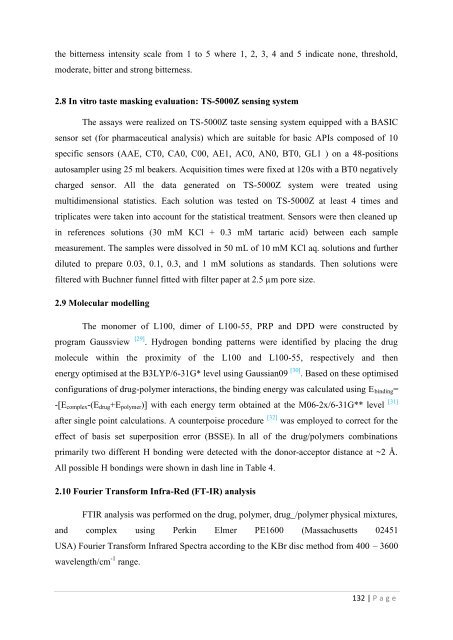Development of hot-melt extrusion as a novel technique for the ...
Development of hot-melt extrusion as a novel technique for the ...
Development of hot-melt extrusion as a novel technique for the ...
You also want an ePaper? Increase the reach of your titles
YUMPU automatically turns print PDFs into web optimized ePapers that Google loves.
<strong>the</strong> bitterness intensity scale from 1 to 5 where 1, 2, 3, 4 and 5 indicate none, threshold,moderate, bitter and strong bitterness.2.8 In vitro t<strong>as</strong>te m<strong>as</strong>king evaluation: TS-5000Z sensing systemThe <strong>as</strong>says were realized on TS-5000Z t<strong>as</strong>te sensing system equipped with a BASICsensor set (<strong>for</strong> pharmaceutical analysis) which are suitable <strong>for</strong> b<strong>as</strong>ic APIs composed <strong>of</strong> 10specific sensors (AAE, CT0, CA0, C00, AE1, AC0, AN0, BT0, GL1 ) on a 48-positionsautosampler using 25 ml beakers. Acquisition times were fixed at 120s with a BT0 negativelycharged sensor. All <strong>the</strong> data generated on TS-5000Z system were treated usingmultidimensional statistics. Each solution w<strong>as</strong> tested on TS-5000Z at le<strong>as</strong>t 4 times andtriplicates were taken into account <strong>for</strong> <strong>the</strong> statistical treatment. Sensors were <strong>the</strong>n cleaned upin references solutions (30 mM KCl + 0.3 mM tartaric acid) between each sampleme<strong>as</strong>urement. The samples were dissolved in 50 mL <strong>of</strong> 10 mM KCl aq. solutions and fur<strong>the</strong>rdiluted to prepare 0.03, 0.1, 0.3, and 1 mM solutions <strong>as</strong> standards. Then solutions werefiltered with Buchner funnel fitted with filter paper at 2.5 µm pore size.2.9 Molecular modellingThe monomer <strong>of</strong> L100, dimer <strong>of</strong> L100-55, PRP and DPD were constructed byprogram Gaussview [29] . Hydrogen bonding patterns were identified by placing <strong>the</strong> drugmolecule within <strong>the</strong> proximity <strong>of</strong> <strong>the</strong> L100 and L100-55, respectively and <strong>the</strong>nenergy optimised at <strong>the</strong> B3LYP/6-31G* level using Gaussian09 [30] . B<strong>as</strong>ed on <strong>the</strong>se optimisedconfigurations <strong>of</strong> drug-polymer interactions, <strong>the</strong> binding energy w<strong>as</strong> calculated using E binding =-[E complex -(E drug +E polymer )] with each energy term obtained at <strong>the</strong> M06-2x/6-31G** level [31]after single point calculations. A counterpoise procedure [32] w<strong>as</strong> employed to correct <strong>for</strong> <strong>the</strong>effect <strong>of</strong> b<strong>as</strong>is set superposition error (BSSE). In all <strong>of</strong> <strong>the</strong> drug/polymers combinationsprimarily two different H bonding were detected with <strong>the</strong> donor-acceptor distance at ~2 Å.All possible H bondings were shown in d<strong>as</strong>h line in Table 4.2.10 Fourier Trans<strong>for</strong>m Infra-Red (FT-IR) analysisFTIR analysis w<strong>as</strong> per<strong>for</strong>med on <strong>the</strong> drug, polymer, drug_/polymer physical mixtures,and complex using Perkin Elmer PE1600 (M<strong>as</strong>sachusetts 02451USA) Fourier Trans<strong>for</strong>m Infrared Spectra according to <strong>the</strong> KBr disc method from 400 – 3600wavelength/cm -1 range.132 | P a g e
















